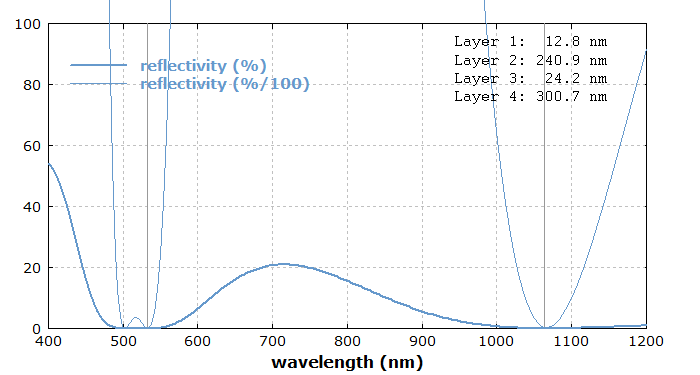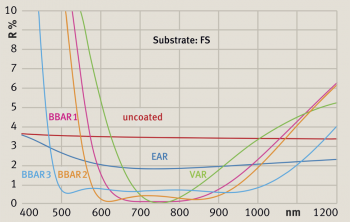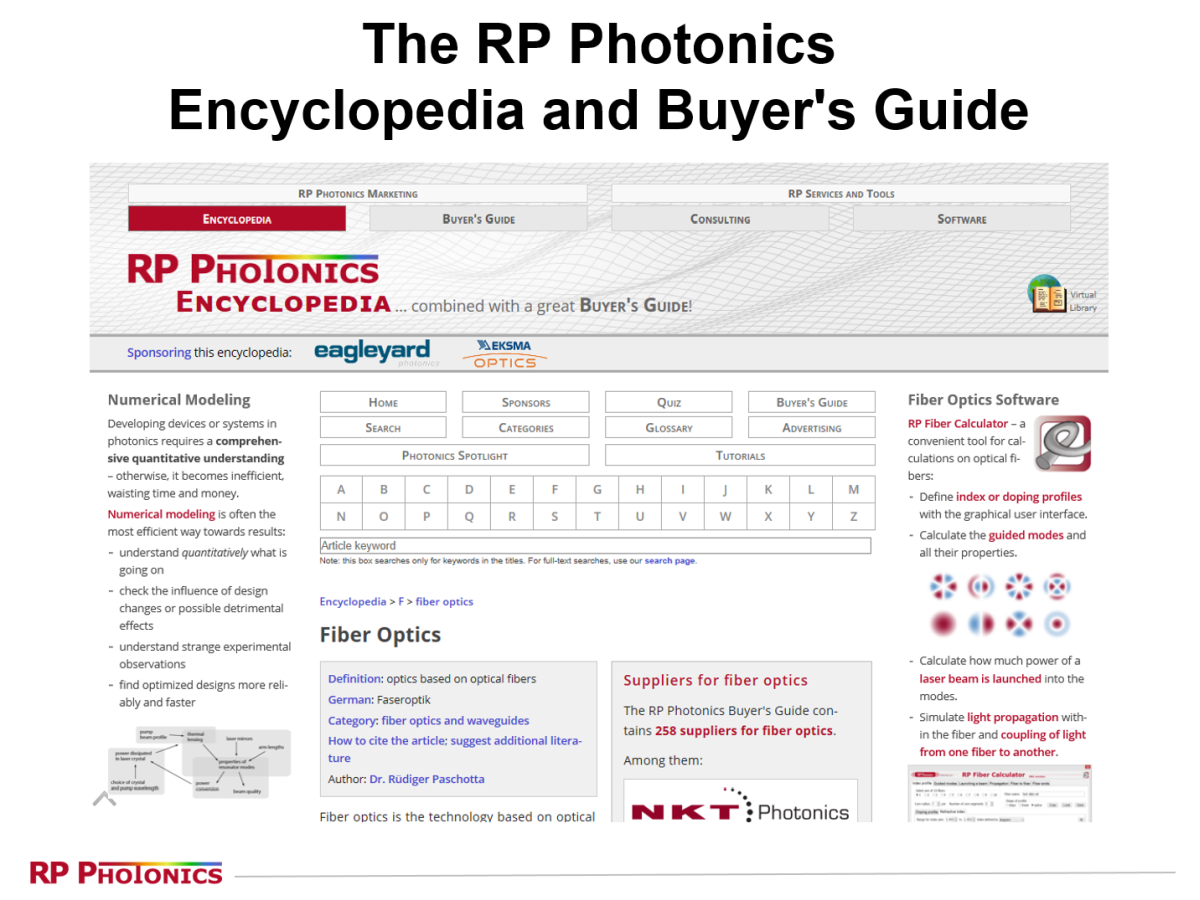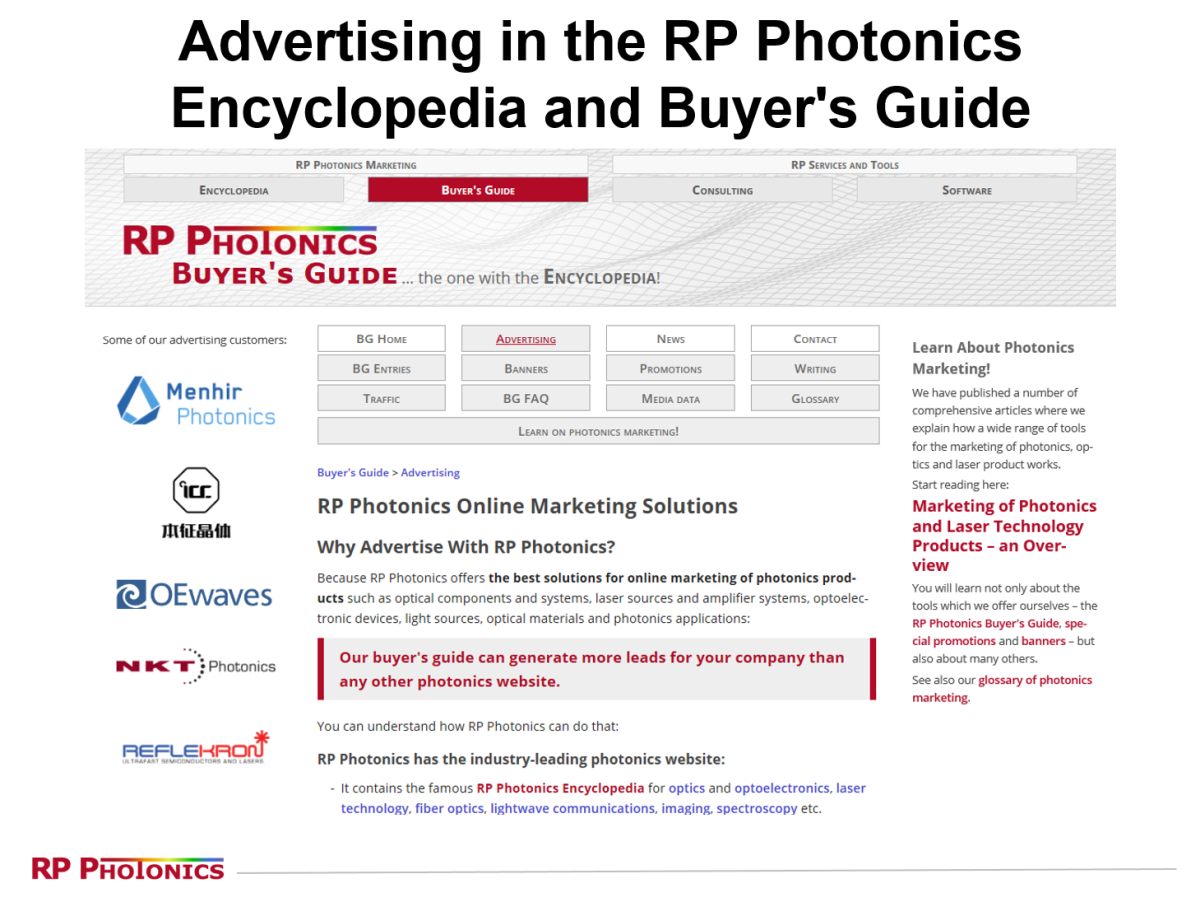Anti-reflection Coatings
Acronym: AR coating
Definition: optical thin-film coatings for reducing reflections from surfaces
More general terms: dielectric coatings
German: Anti-Reflex-Beschichtungen
How to cite the article; suggest additional literature
Author: Dr. Rüdiger Paschotta
An anti-reflection coating (AR coating) is a dielectric thin-film coating applied to an optical surface in order to reduce the reflectance (also often called reflectivity) of that surface due to Fresnel reflections – at least in a certain wavelength range. Examples for the application of such coatings are spectacles, optical systems like camera objectives, optical windows, displays and solar cells.
In most cases, the basic principle of operation is that reflected waves from different optical interfaces largely cancel each other by destructive interference.
Note that there are also anti-glare surfaces, which suppress reflections in a completely different way: by diffuse scattering from a microscopically rough surface. Such surfaces are suitable e.g. for some viewing ports, but normally not for laser applications, and should be carefully distinguished from anti-reflection surfaces.
Single-layer Anti-reflection Coatings
In the simplest case, an anti-reflection thin-film coating designed for normal incidence consists of a single quarter-wave layer of a material the refractive index of which is close to the geometric mean value of the refractive indices of the two adjacent media. In that situation, two reflections of equal magnitude arise at the two interfaces, and these cancel each other by destructive interference.
The limitations of this approach are twofold:
- It is not always possible to find a coating material with suitable refractive index, particularly in cases where the bulk medium has a relatively low refractive index (e.g. in case of plastic optics).
- A single-layer coating works only in a limited bandwidth (wavelength range).
Multilayer Coatings
If no suitable medium for a single-layer coating can be found, or if anti-reflective properties are required for a very broad wavelength range (or for different wavelength ranges simultaneously, or for different angles of incidence), more complicated designs may be used, which usually have to be found using numerical techniques. A general trade-off of such multilayer designs is between a low residual reflectance and a large bandwidth. So-called V coatings have a high performance only in a narrow bandwidth (order of 10 nm), whereas broadband coatings offer moderate performance but in a wide wavelength range.

Apart from those properties, the tolerance to growth errors may also be of interest: there are sophisticated coating designs which reach a high performance only for very precise manufacturing. The growth error tolerance is therefore an important aspect to be considered in the design.
Multilayer anti-reflection coatings are often applied to optical glasses, but they can also be used for plastic optics.
Design Methods
Analytical design rules exist for simple types of anti-reflection coatings with very few thin-film layers. For more sophisticated designs, numerical optimization algorithms similar to those described in the article on dielectric mirrors can be used. The resulting designs are normally not easily understood, as the anti-reflection properties result from a complicated interference of the reflections from various interfaces.
Gradient Index Coatings
A wide range of possibilities arises from gradient index coatings (or graded-index coatings) [2, 3, 11], where the composition of a layer material is gradually varied. In the simplest case, a smooth index transition between two optical materials over a length scale of a few wavelengths can suppress fairly well the reflection over a wide spectral and angular range. This is difficult to realize, however, for surfaces next to air, since all solid materials have a refractive index significantly different from that of air. One solution is to use nanooptics in the form of sub-wavelength pyramid structures or the like (moth eye structure), see e.g. Refs. [1], [2] and [7]. Such structures imitate a smooth transition of the refractive index to 1 by smoothly reducing the amount of solid material in a plane parallel to the surface. However, there are also solutions without nanooptics, in particular the integration of gradient index layers into a multilayer coating. This allows for good broadband anti-reflection properties in a wide angular range without using materials with a very small refractive index.
Coatings with Strongly Absorbing Layers
An unusual type of anti-reflection coating is one consisting of a very thin layer of some strongly absorbing material. The thickness can be only some tens of nanometers, i.e., far less than usually required for lossless AR coatings, as strong imaginary components of the propagation constant of such media lead to substantial phase changes. The incident light is largely absorbed by such structures, rather than transmitted. Such anti-reflection structures are sometimes called photonic metamaterials due to the combination of sub-wavelength structures, although simple interference phenomena are sufficient for understanding their characteristics [13].
Applications
Anti-reflection coatings [3] are often used for optical components in order to reduce optical losses and sometimes also the detrimental influence of reflected beams. The residual reflectance for a given wavelength and angle of incidence is often of the order of 0.2%, or less (in a limited bandwidth) with careful optimization. For application on prescription glasses, the achievable suppression of reflections is significantly lower, since the coating must operate in a wide wavelength range and for a wide range of incidence angles. AR coatings are also used on laser crystals and nonlinear crystals. In such cases, additional challenges can arise from anisotropic thermal expansion e.g. of lithium triborate (LBO) crystals.
In most cases, AR coatings are used on optical interfaces with an area of at least a few millimeters squared. However, it is also possible to produce such coatings on the ends of optical fibers, sometimes even in jacketed and connectorized assemblies. There are various technical difficulties, e.g. related to outgasing of polymer jackets in a vacuum chamber and to the limited number of fiber ends which can be treated in one batch, but specialized sputtering processes have been developed which mitigate these problems. The coating performance can be as good as for normal bulk surfaces, at least for simple coating designs with only fewer layers.
Damage Threshold
Apart from the reflection properties, the optical damage threshold of anti-reflection coatings can be of interest, for example for use in components for Q-switched lasers. Depending on the material combination, an AR coating can have a higher or lower damage threshold than the substrate material.
Even for given coating materials, the damage threshold can vary considerably depending on the fabrication technique. Ion beam sputtering is known to allow for relatively high damage thresholds.
Suppliers
The RP Photonics Buyer's Guide contains 125 suppliers for anti-reflection coatings. Among them:

EKSMA OPTICS
In the EKSMA Optics IBS thin-film coating facility, we can design and produce complex low loss anti-reflection coatings to suit your application.

Dynasil
EMF, a Dynasil company, offers single layer, multi-layer and BBAR high-efficiency AR coatings including diamond-like carbon (DLC) for UV, IR and NIR. It offers AR coatings on glass, sapphire, germanium (Ge), zinc selenide (ZnSe), zinc sulfide (ZnS), calcium fluoride (CaF2) and chalcogenides.


VisiMax Technologies
VisiClear anti-reflection coatings are used in many different applications, across a wide variety of industries and across the globe. Select from an assortment of VisiClear options: VisiClear for glass, VisiClear for plastic, and high-performance VisiClear Ultra BBAR™ (broad band anti-reflection).
VisiClear AR coatings withstand extreme environmental conditions. When used in combination with optional VisiMax process protective coatings, VisiClear coatings provide extraordinary abrasion, moisture, and soil resistance.

Knight Optical
For maximum transmission, Knight Optical offers a range of AR coatings to reduce optical reflectivity. Available as single-layer (for 0.9–20 µm wavebands) or multi-layer options (for 3–5 µm, 5–8 µm or 8–12 µm wavebands), our AR coatings boast industry-leading performance. Furthermore, AR options can be customised to meet specific wavelength requirements.


Laseroptik
LASEROPTIK offers a wide range of anti-reflection coatings for various types of optical elements in different wavelength regions from the mid IR to the UV. We can also supply coatings on special substrates and coatings for special applications.

Shanghai Optics
Shanghai Optics provides custom anti-reflection coatings with appropriate materials and optimized configuration on a substrate material specified by the customer, with specified transmittance and a specified wavelength region.

Iridian Spectral Technologies
Iridian provides coating services for a variety of component materials such as glass, silicon, semiconductors and certain plastic substrates or films. Precision coatings can be applied to beam-splitters, prisms, lenses, mirrors, windows, ferrules and laser facets. Both prototype volume and high volume capability is available.
Coating types include simple anti-reflection (ARs) and broadband coatings.
Questions and Comments from Users
Here you can submit questions and comments. As far as they get accepted by the author, they will appear above this paragraph together with the author’s answer. The author will decide on acceptance based on certain criteria. Essentially, the issue must be of sufficiently broad interest.
Please do not enter personal data here; we would otherwise delete it soon. (See also our privacy declaration.) If you wish to receive personal feedback or consultancy from the author, please contact him e.g. via e-mail.
By submitting the information, you give your consent to the potential publication of your inputs on our website according to our rules. (If you later retract your consent, we will delete those inputs.) As your inputs are first reviewed by the author, they may be published with some delay.
Bibliography
| [1] | P. B. Clapham and M. C. Hutley, “Reduction of lens reflexion by the 'Moth Eye' principle”, Nature 244, 281 (1973), doi:10.1038/244281a0 |
| [2] | W. H. Lowdermilk and D. Milam, “Graded-index antireflection surfaces for high-power laser applications”, Appl. Phys. Lett. 36 (11), 891 (1980), doi:10.1063/1.91373 |
| [3] | W. H. Southwell, “Gradient-index antireflection coatings”, Opt. Lett. 8 (11), 584 (1983), doi:10.1364/OL.8.000584 |
| [4] | J. A. Dobrowolski et al., “Optimal single-band normal-incidence antireflection coatings”, Appl. Opt. 35 (4), 644 (1996), doi:10.1364/AO.35.000644 |
| [5] | V. Janicki et al., “Hybrid optical coating design for omnidirectional antireflection purposes”, J. Opt. A: Pure Appl. Opt. 7, L9 (2005) |
| [6] | J.-Q. Xi et al., “Optical thin-film materials with low refractive index for broadband elimination of Fresnel reflection”, Nature Photon. 1, 176 (2007), doi:10.1038/nphoton.2007.26 |
| [7] | N. C. Linn et al., “Self-assembled biomimetic antireflection coatings”, Appl. Phys. Lett. 91, 101108 (2007), doi:10.1063/1.2783475 |
| [8] | D. S. Hobbs and B. D. MacLeod, “High laser damage threshold surface relief micro-structures for anti-reflection applications”, SPIE 6720, 67200L (2007), doi:10.1117/12.754223 |
| [9] | N. I. Landy et al., “Perfect metamaterial absorber”, Phys. Rev. Lett. 100 (20), 207402 (2008), doi:10.1103/PhysRevLett.100.207402 |
| [10] | T. V. Amotchkina, “Empirical expression for the minimum residual reflectance of normal- and oblique-incidence antireflection coatings”, Appl. Opt. 47 (17), 3109 (2008), doi:10.1364/AO.47.003109 |
| [11] | D. J. Poxson et al., “Broadband omnidirectional antireflection coatings optimized by genetic algorithm”, Opt. Lett. 34 (6), 728 (2009), doi:10.1364/OL.34.000728 |
| [12] | T. V. Amotchkina et al., “Design, production, and reverse engineering of two-octave antireflection coatings”, Appl. Opt. 50 (35), 6468 (2011), doi:10.1364/AO.50.006468 |
| [13] | H. Chen, “Interference theory of metamaterial perfect absorbers”, Opt. Express 20 (7), 7165 (2012), doi:10.1364/OE.20.007165 |
| [14] | W. Streyer et al., “Strong absorption and selective emission from engineered metals with dielectric coatings”, Opt. Express 21 (7), 9113 (2013), doi:10.1364/OE.21.009113 |
| [15] | Design of an anti-reflection coating with the RP Coating software |
See also: reflectance, dielectric coatings, dielectric mirrors, Fresnel reflections, black coatings
and other articles in the category photonic devices
 |






If you like this page, please share the link with your friends and colleagues, e.g. via social media:
These sharing buttons are implemented in a privacy-friendly way!